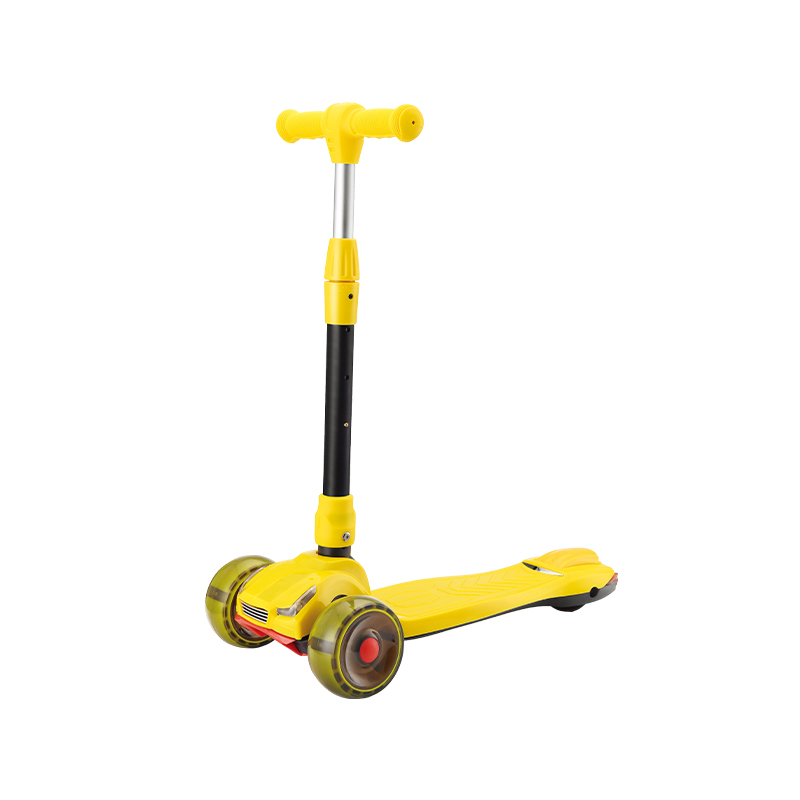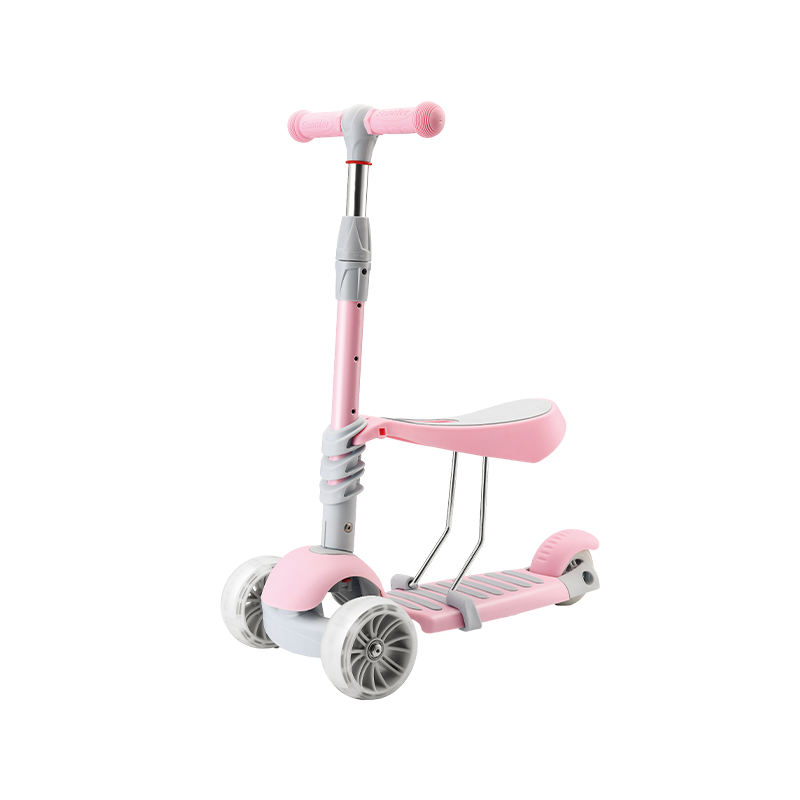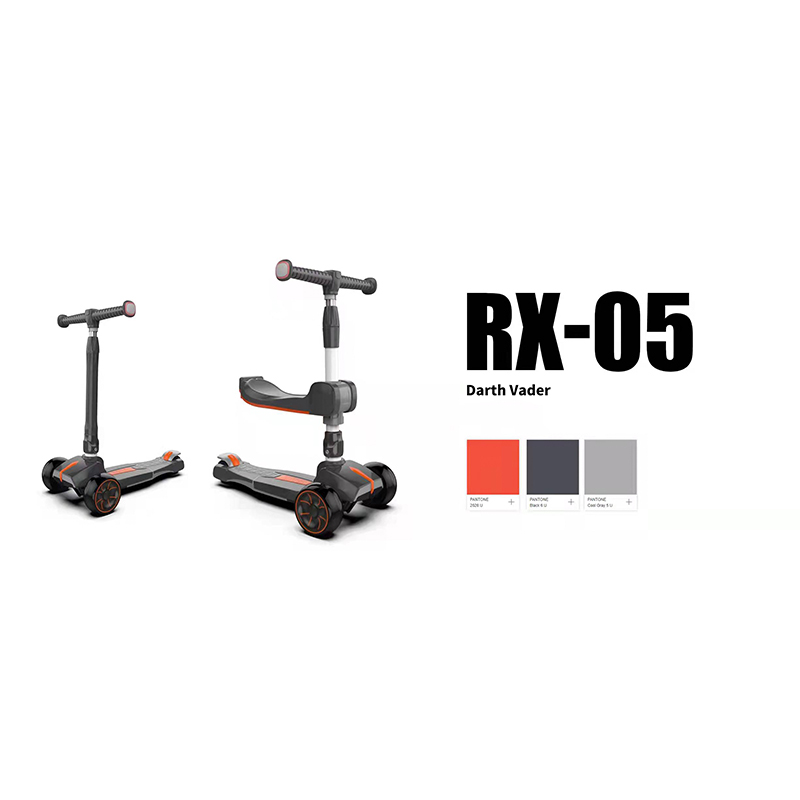How does a children's scooter ensure the safety of children's riding?
Release Time : 2025-06-19
As a popular outdoor toy, the design of children's scooter is primarily designed to ensure the safety of children's riding. Through a variety of well-designed safety features and humanized considerations, high-quality children's scooters can provide all-round protection while children enjoy fun, so that parents can rest assured.
First of all, the structural design of children's scooters fully considers safety. The sturdy and durable body frame is one of the basic guarantees. It can withstand various impacts and pressures in daily use, ensuring that the scooter will not be damaged due to minor collisions or long-term use. At the same time, the good center of gravity distribution makes the scooter more stable and reduces the risk of rollover. Whether on a flat road or a slightly uneven ground, children can control the scooter smoothly, reducing the possibility of falling due to loss of balance.
Secondly, the reliability of the brake system is crucial to riding safety. Most high-quality children's scooters are equipped with sensitive and easy-to-operate handbrakes or footbrakes. These brake systems have been rigorously tested to respond quickly and effectively slow down or stop the scooter when needed. The handbrake is usually located at the handlebar, which is convenient for children to control the speed at any time during riding; while the footbrake is located above the rear wheel, using the power of the foot to apply braking force. The combination of the two allows children to flexibly choose the braking method according to the actual situation and increase safety.
In addition, the choice of tires is also a key factor affecting the safety performance of scooters. High-quality rubber tires have excellent grip and shock absorption effects. They can not only maintain good traction on slippery roads, but also absorb the vibration caused by bumps on the road, making the riding process more stable and comfortable. Some high-end products even use pneumatic tires to further improve the buffering capacity and driving stability, and can cope with more complex terrains. In addition, the design of the tire pattern also fully considers drainage and anti-skid properties to ensure that reliable traction can still be provided in rainy or humid environments.
It is worth mentioning that the ergonomic design of children's scooters also adds a lot of points to riding safety. The appropriate handlebar height and width, comfortable pedal size, and ergonomic seat (if equipped) and other details can make children's body posture naturally relaxed and avoid fatigue and discomfort caused by long-term bad posture. The correct sitting or standing posture helps children better control the scooter and respond quickly in emergency situations. For example, a reasonable handlebar position makes it easy for children to turn, while a spacious pedal provides enough standing space to prevent their feet from slipping and causing accidents.
In addition to the above hardware safety guarantees, many children's scooters also pay attention to software-level safety measures. For example, some products are equipped with reflective strips or LED lights to improve visibility at night or in low light conditions, reminding pedestrians and vehicles around to avoid them. This seemingly simple additional function can play an important role at critical moments, especially at dusk or early morning when visibility is low. The role of reflective strips and lights is particularly significant.
In addition, the adjustability of children's scooters is also an important aspect to ensure safety. As children grow, their height and weight will change, so a good scooter should allow users to adjust parameters such as handlebar height and seat position according to actual needs. This not only adapts to children of different ages, but also ensures that each user can ride in the most comfortable state, thereby reducing safety hazards caused by inappropriate body posture.
From an educational perspective, children's scooters also help cultivate children's awareness of traffic safety. In the process of learning how to use scooters correctly, children will gradually understand traffic rules, learn to observe road conditions, and judge when to speed up, slow down or stop. These valuable experiences are not only beneficial for current scooter riding, but also lay a solid foundation for future participation in more complex transportation activities.
Finally, buying children's scooters produced by regular brands is also an important part of ensuring safety. Manufacturers of well-known brands often follow strict production standards, and every process from raw material procurement to finished product delivery undergoes strict quality inspections. They also regularly launch new products and technology upgrades to meet changing market demands and safety requirements. At the same time, products sold through regular channels usually come with detailed instruction manuals and after-sales service policies to help parents and children better understand and maintain scooters, extend their service life, and ensure that every ride is a safe and enjoyable experience.
In summary, children's scooters have made comprehensive efforts to ensure children's riding safety through a series of well-designed safety features. Whether it is structural strength, brake system, tire performance or ergonomic design, every detail reflects the concern and care for the healthy growth of children. With the advancement of technology and social development, I believe that children's scooters in the future will be more intelligent and convenient, and continue to accompany generations of children to spend a happy childhood.
First of all, the structural design of children's scooters fully considers safety. The sturdy and durable body frame is one of the basic guarantees. It can withstand various impacts and pressures in daily use, ensuring that the scooter will not be damaged due to minor collisions or long-term use. At the same time, the good center of gravity distribution makes the scooter more stable and reduces the risk of rollover. Whether on a flat road or a slightly uneven ground, children can control the scooter smoothly, reducing the possibility of falling due to loss of balance.
Secondly, the reliability of the brake system is crucial to riding safety. Most high-quality children's scooters are equipped with sensitive and easy-to-operate handbrakes or footbrakes. These brake systems have been rigorously tested to respond quickly and effectively slow down or stop the scooter when needed. The handbrake is usually located at the handlebar, which is convenient for children to control the speed at any time during riding; while the footbrake is located above the rear wheel, using the power of the foot to apply braking force. The combination of the two allows children to flexibly choose the braking method according to the actual situation and increase safety.
In addition, the choice of tires is also a key factor affecting the safety performance of scooters. High-quality rubber tires have excellent grip and shock absorption effects. They can not only maintain good traction on slippery roads, but also absorb the vibration caused by bumps on the road, making the riding process more stable and comfortable. Some high-end products even use pneumatic tires to further improve the buffering capacity and driving stability, and can cope with more complex terrains. In addition, the design of the tire pattern also fully considers drainage and anti-skid properties to ensure that reliable traction can still be provided in rainy or humid environments.
It is worth mentioning that the ergonomic design of children's scooters also adds a lot of points to riding safety. The appropriate handlebar height and width, comfortable pedal size, and ergonomic seat (if equipped) and other details can make children's body posture naturally relaxed and avoid fatigue and discomfort caused by long-term bad posture. The correct sitting or standing posture helps children better control the scooter and respond quickly in emergency situations. For example, a reasonable handlebar position makes it easy for children to turn, while a spacious pedal provides enough standing space to prevent their feet from slipping and causing accidents.
In addition to the above hardware safety guarantees, many children's scooters also pay attention to software-level safety measures. For example, some products are equipped with reflective strips or LED lights to improve visibility at night or in low light conditions, reminding pedestrians and vehicles around to avoid them. This seemingly simple additional function can play an important role at critical moments, especially at dusk or early morning when visibility is low. The role of reflective strips and lights is particularly significant.
In addition, the adjustability of children's scooters is also an important aspect to ensure safety. As children grow, their height and weight will change, so a good scooter should allow users to adjust parameters such as handlebar height and seat position according to actual needs. This not only adapts to children of different ages, but also ensures that each user can ride in the most comfortable state, thereby reducing safety hazards caused by inappropriate body posture.
From an educational perspective, children's scooters also help cultivate children's awareness of traffic safety. In the process of learning how to use scooters correctly, children will gradually understand traffic rules, learn to observe road conditions, and judge when to speed up, slow down or stop. These valuable experiences are not only beneficial for current scooter riding, but also lay a solid foundation for future participation in more complex transportation activities.
Finally, buying children's scooters produced by regular brands is also an important part of ensuring safety. Manufacturers of well-known brands often follow strict production standards, and every process from raw material procurement to finished product delivery undergoes strict quality inspections. They also regularly launch new products and technology upgrades to meet changing market demands and safety requirements. At the same time, products sold through regular channels usually come with detailed instruction manuals and after-sales service policies to help parents and children better understand and maintain scooters, extend their service life, and ensure that every ride is a safe and enjoyable experience.
In summary, children's scooters have made comprehensive efforts to ensure children's riding safety through a series of well-designed safety features. Whether it is structural strength, brake system, tire performance or ergonomic design, every detail reflects the concern and care for the healthy growth of children. With the advancement of technology and social development, I believe that children's scooters in the future will be more intelligent and convenient, and continue to accompany generations of children to spend a happy childhood.







